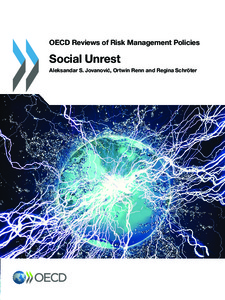Social unrest
"This report develops a framework of social unrest within a complex understanding of systemic risk. The goal is to try to identify triggers (events that lead to social unrest) and drivers (causal roots) for the emergence of social unrest and, based on this functional analysis, to design policy...
| Main Authors: | , , |
|---|---|
| Institution: | ETUI-European Trade Union Institute |
| Format: | TEXT |
| Language: | English |
| Published: |
Paris
2012
OECD |
| Subjects: | |
| Online Access: | https://www.labourline.org/KENTIKA-19131925124919591079-Social-unrest.htm |
| _version_ | 1771659901686251520 |
|---|---|
| author | Jovanovic, Aleksandar S. Renn, Ortwin Schröter, Regina |
| author_facet | Jovanovic, Aleksandar S. Renn, Ortwin Schröter, Regina |
| collection | Library items |
| description | "This report develops a framework of social unrest within a complex understanding of systemic risk. The goal is to try to identify triggers (events that lead to social unrest) and drivers (causal roots) for the emergence of social unrest and, based on this functional analysis, to design policy options on how to avoid, mitigate or handle unrest. The framework should enable a better understanding of the circumstances that may trigger social unrest, how intensely that unrest is likely to materialize and what interventions promise to de-escalate the conflict or even prevent social unrest in the first place. Since social unrest is more a process of escalation than a finite state of the world, the term has been conceptualized in a step-by-step escalation scheme. Each step makes social unrest more severe. It is a gradual framework that identifies the different stages that make social unrest more and more probable. In order to identify relevant drivers and cluster of drivers, three case studies are investigated: pandemics, cyber-related risk and financial crises. The main question is how did or could these events cause social unrests. In a second step, an analytic model is used to capture the combined effects learned from the case study analysis. In a third step,the IRGC risk governance model for explaining the risk of social unrest or predicting the consequences of social unrest is applied. Finally , guidelines for normative governance with respect to social unrest are developed." |
| format | TEXT |
| id | 19131925124919591079_7893d3f4a4e94337b2082f557ba0f286 |
| institution | ETUI-European Trade Union Institute |
| is_hierarchy_id | 19131925124919591079_7893d3f4a4e94337b2082f557ba0f286 |
| is_hierarchy_title | Social unrest |
| language | English |
| physical | 101 p. Digital |
| publishDate | 2012 |
| publisher | Paris OECD |
| spellingShingle | Jovanovic, Aleksandar S. Renn, Ortwin Schröter, Regina case study economic recession government attitude labour dispute Social unrest |
| thumbnail | https://www.labourline.org/Image_prev.jpg?Archive=111335793951 |
| title | Social unrest |
| topic | case study economic recession government attitude labour dispute |
| url | https://www.labourline.org/KENTIKA-19131925124919591079-Social-unrest.htm |

